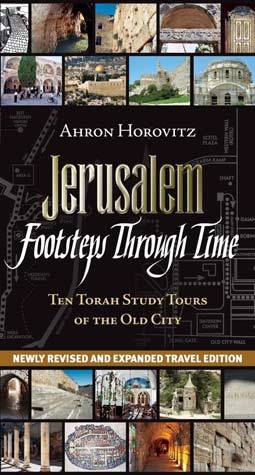The Kosher Bookworm: A Yom Yerushalayim tribute and review
The Kosher Bookworm
By Alan Jay Gerber
Issue of May 7, 2010/ 23 Iyar, 5770
With the annual observance of Yom Yerushalayim this Wednesday, May 12, this week’s essay will be a brief review of several works dealing with the history and legacy of Jerusalem. Ever the center of world attention and envy, the spiritual and political capital of our people has yet to see true peace. Whether it be a terrorist blast or a presidential screed, or a local member of Congress’s studied indifference, Jerusalem has seen the ire of most of the world since time immemorial.
When we were kids, both to save time and nurture our laziness, we would resort to reading Cliff Notes instead of the assigned novels and plays. Today, such convenient manual as the “Dummies” and “Idiot’s Guide” series have come to serve the same utilitarian purpose. The following guidebooks and brief histories, whatever their faults, do not fall into this category. Each in their own way comes with a full-fledged history of a troubled city and a geographical destination that would be the envy of any other city in the world today.
We start with my favorite, “Jerusalem: Footsteps Through Time” (Feldheim 2009), a book that consists of 10 Torah-based study tours of the Old City.
Truth be told from the outset, this volume is not just a guidebook with details. It is a first-class history and geography lesson of Jerusalem formatted into a guidebook for your learning pleasure. Even if you were never to visit Jerusalem, this book can serve as a surrogate guide to all of the important historical and religious holy sites made famous by the events of our Biblical and post-Biblical past.
Within these 10 tours are the whole panorama of the events and personalities of antiquity through the middle ages and our own times. Events such as the churban to the Six-Day War and the bravery of our troops, the shofar blasts at the newly liberated Kotel by Rabbi Shlomo Goren, zt”l, are all brought together for us to read and appreciate the sacredness of this city of the faith that has preserved its memory through these past 2,000 years of exile.
This book is published in a handy, pocket-sized format that can easily serve as a companion on your trips around Jerusalem. It is both attractive and user-friendly.
Florida native Ahron Horovitz is to be commended for his meticulous and skilled work in the presentation of this work. I trust that at some point during my upcoming visit to Israel I will have the opportunity to meet him and to visit his City of David Institute to learn first-hand of his excellent work at preserving our national heritage.
The next book is titled, “Jerusalem: Portrait of the City in the Second Temple Period” (Jewish Publications Society, 2002). The author of the book is the distinguished Hebrew University scholar, historian and essayist, Dr. Lee Levine.
In this book, Levine details in text, pictures and clear prose the entire gamut of one of the most tumultuous periods of Jerusalem’s Jewish history.
As our ancient capital, a fact recognized by all the civilized world of that time, Levine goes into great detail in describing the political dynamics, both religious and political, that influenced the events of that era which eventually led to the destruction of the Temple and the Jewish presence in Jerusalem for the next 2,000 years.
Starting from the Persian era, leading through the rule of the Hellenic era, and ultimately the rule by Rome, Levine describes the various nuances that made for the motivations of individuals and nations during this long span of six centuries of our people’s history.
All strata of society are given their descriptive due, each demonstrating how the human fault line of ego and religious fanaticism came to play a crucial role in the ruin of both a city and a civilization.
With the onset of the Three Weeks due to start early this year on June 29, this volume would make for some timely early summer reading . Given the ongoing centrality of Jerusalem in international debate, fueled in no small measure by our own government, a good reading of this book would serves us by giving some great historical background material to serve as talking points on this most important of issues facing us today.
I would like to conclude by just briefly noting two works by Cambridge professor Simon Goldhill. His first book is titled “The Temple of Jerusalem” and the second is “Jerusalem: City of Longing”. Both are published by Harvard University Press and feature detailed and scholarly histories of the holy city from a very dispassionate point of view.
While space doesn’t permit here a full critical treatment, if you want to learn the mentality behind the utter indifference of many to our claims to Jerusalem, a good reading of these two books will surely help you along.

 51.0°,
Overcast
51.0°,
Overcast 




